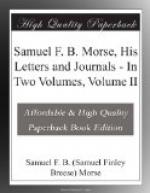It was in the year 1835 that Morse was appointed Professor of the Literature of the Arts of Design in the University of the City of New York, and here again we can mark the guiding hand of Fate. A few years earlier he had been tentatively offered the position of instructor of drawing at the United States Military Academy at West Point, but this offer he had promptly but courteously declined. Had he accepted it he would have missed the opportunity of meeting certain men who gave him valuable assistance. As an instructor in the University he not only received a small salary which relieved him, in a measure, from the grinding necessity of painting pot-boilers, but he had assigned to him spacious rooms in the building on Washington Square, which he could utilize not only as studio and living apartments, but as a workshop. For these rooms, however, he paid a rent, at first of $325 a year, afterwards of $400.
Three years had clasped since his first conception of the invention, and, although burning to devote himself to its perfecting, he had been compelled to hold himself in check and to devote all his time to painting. Now, however, an opportunity came to him, for he moved into the University building before it was entirely finished, and the stairways were in such an embryonic state that he could not expect sitters to attempt their perilous ascent. This enforced leisure gave him the chance he had long desired and he threw himself heart and soul into his electrical experiments. Writing of this period in later years he thus records his struggles:—
[Illustration: FIRST TELEGRAPH INSTRUMENT, 1837 Now in the National Museum, Washington]
“There I immediately commenced, with very limited means, to experiment upon my invention. My first instrument was made up of an old picture or canvas frame fastened to a table; the wheels of an old wooden clock moved by a weight to carry the paper forward; three wooden drums, upon one of which the paper was wound and passed over the other two; a wooden pendulum, suspended to the top piece of the picture or stretching-frame, and vibrating across the paper as it passes over the centre wooden drum; a pencil at the lower end of the pendulum in contact with the paper; an electro-magnet fastened to a shelf across the picture or stretching frame, opposite to an armature made fast to the pendulum; a type rule and type, for breaking the circuit, resting on an endless band composed of carpet-binding; which passed over two wooden rollers, moved by a wooden crank, and carried forward by points projecting from the bottom of the rule downward into the carpet-binding; a lever, with a small weight on the upper side, and a tooth projecting downward at one end, operated on by the type, and a metallic fork, also projecting downward, over two mercury cups; and a short circuit of wire embracing the helices of the electro-magnet connected with the positive and negative poles of the battery and terminating in the mercury cups.”




